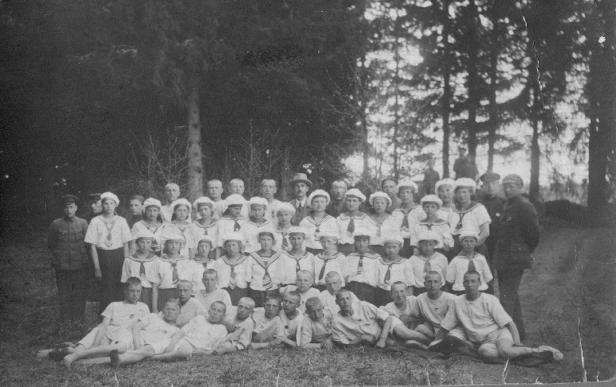
Russian Youth Groups: Unknown Groups

Figure 1.--We note a photograph showing an unknown camp group, we think during the early Soviet period. We don't think it is a Tsarist youth or school group because it is a coed group. As far as we know, Tsarist groups abd schools (except for rural primary schools) separated the genders. Soviet attitudes, especialy during the early Soviet period, were far more free spirited when in came to gender. Only later did the Soviets become more prudish about such ,attrs. The children here are wearing uniforms. They look to be secondary-level students.
|
|
We notice several groups like look like youth groups or groups involved in what look like youth group activities. This includes groups in Tsarist Russia, theSoviet Union, and post-Soviet Russia. These images cover an era of trenemendous change, so they give us insights into what was happening in the Tsarist/Soviet empire. We know something abouut several of these groups nd next to nothing about several of them. Hopefully our Russian readers will be able to tell us more.
Unknown Camp Group
We note a photograph showing an unknown camp group, we think during the early Soviet period. We don't think it is a Tsarist youth or school group because it is a coed group. As far as we know, Tsarist groups abd schools (except for rural primary schools) separated the genders. Soviet attitudes, especialy during the early Soviet period, were far more free spirited when in came to gender. Only later did the Soviets become more prudish about such ,attrs. The children here are wearing uniforms (figure 1). They look to be secondary-level students. The girls wear sailor outfits. It gives them a bourgeois look, but was common in Tsarist and early-Soviet schools at the time. The boys seem to be wearing white sailor square-necked blouses and shorts. This could be gym unifoms, but the backgrond suggests that this was some kind of camp. It might be an eaely Pioneer groupm but we can not confirm this. The soldiers with them suggest the erly-Soviet period, sone ime aftr the Civil War, perhaps about 1925.
We note what looks to be a youth organization operating summer camps in post-Soviet Ukraine. It appears to be using summer camp facilities of the old Pioneer movement. We know nothing about the groups, even if it is Russian, Ukranian, or some kind of international group. The camp appears to have begun operating in 1997. It may be simply a private group operating a camp, but recruitmnt through schools and the uniforms involved suggest some kind of organization. We have however, no information on that organization or indeed on just who sponsors or operates the camp. We note that some children from the former Soviet Central Asian republics attend the camps. The activities seem to be traditional camp fare with computers added in. Activities included: hikes, games, sailing, picnics,and computer training. Some of te activities seem a bit rough, note the battle scared boys. One has a cut lip. Another has a graze on his knee. A HBU reader reports, "The two children who went from my school enjoyed it. The children were a brother and sister. They flew to the Ukraine and camp leaders met them and took them to the camp. Here they were put into 12 group and they did things together. The other members of the 12 group came from other places." The Ukraine summer camp is located at Hersons on the Black Sea. It is now called Rivers, but was the famous Artek camp in Soviet days. I am not sure who owns and operates the camp today. Children are apparently recruited through schools througout Russia, the Ukraine, and the rest of the post-Soviet Commonwealth.
We know of two Tajik children that attended the camp in 2003. Sponsorship came through the Yuri Gagarin Russian School, Dushanbe, Tajikistan. It is a former Pioneer Camp facility which is now operated by a private children’s camp company. Children attended it from many countries within the Soviet Union. The camp operates on a monthly rotation bases. The two children attending from Tajikistan were there for the 6th session. The camp facilities are found in the city of Hersons. This is located on the Black Sea. The camp is at the Artek complex. Here are many camps. The one the children attended is called Camp River. The Camp logo is a duck in a sailor suit. The children are grouped according to age. The children were placed in two different houses or corps. The boy was a member of 8th corps and his sister was a member of 12th Corps. All the children attended the 6th session or contingent. The area appears to be in a historical part of the Ukraine because the children have been photographed in front of what appears to be Greek style pillars and buildings.
HBU

Navigate the Historic Boys' Uniform Chronology Pages:
[Return to the Main chronologies page]
[The 1900s]
[The 1910s]
[The 1920s]
[The 1930s]
[The 1940s]
[The 1950s]
[The 1960s]
[The 1970s]
[The 1980s]
[The 1990s]
[The 2000s]
Navigate the Historic Boys' Uniform Web Site:
[Activities]
[Biographies]
[Chronologies]
[Countries]
[Essays]
[Garments]
[Organizations]
[Religion]
[Other]
[Introduction]
[Bibliographies]
[Contributions]
[FAQs]
[Questions]
[Unknown images]
[Boys' Uniform Home]
Navigate the Historic Boys' Uniform Web organization pages:
[Return to the Main Russian youth organization page]
[Boys' Brigade]
[Camp Fire]
[Hitler Youth]
[National]
[Pioneers]
[Royal Rangers]
[Scout]
Created: 9:29 PM 5/24/2014
Last updated: 9:29 PM 5/24/2014



